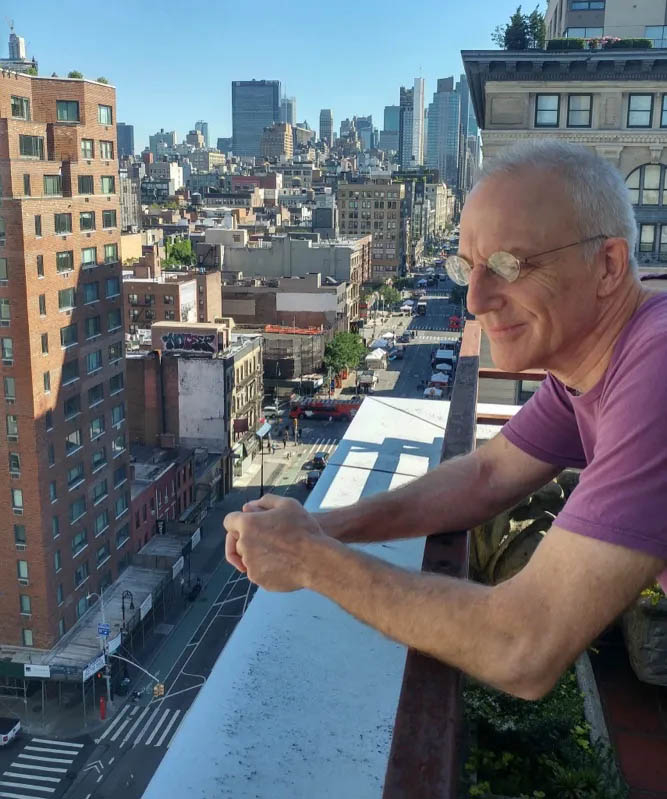
The musical journey for me is one of self-actualization, exploring transitional states and finding new meaning and expression within them. This is the essence of liminality: betwixt and between time, place, identity, and consciousness. Uncertain of what one will find, yet knowing there is no turning back, never to be the same again.”– Eric Johnsen
Based in Tucson, Arizona, composer-producer Eric Johnsen seamlessly weaves together jazz, orchestral, and world elements in a way that is aesthetically rich and complex yet accessible; cerebral but deeply passionate. This sound tapestry is clearly present in his first CD, Liminality, released in June 2023.
Liminality combines an up-to eight-piece improvisational chamber ensemble (piano/keyboards, bass, guitars, voices, flute, drums, tabla, and hand percussion) with a string chamber orchestra. Seeking a space between spaces, the resulting tapestries range from strictly-composed to purely improvisational; from consonant sonorities to dissonance; from full ensemble to solo and duet performances. Sometimes the music floats in ethereal spaces, and other times anchored by a variety of world rhythms.
The space between spaces Eric explores in Liminality varies from piece to piece, reflecting Eric's own process of self-actualization in both the music and lyrics he writes. Some pieces deal with the transformations of finding — or losing — great loves, and integrating those experiences into our new selves. Set to a poem by W.B. Yeats, another piece (All Things Known) reinterprets the traditional stigma of failure. As Eric puts it, “When it comes to the creative process, it's not a question of if we fail, but how we fail - and what we do with it — that determines the depth of our art, forever suspended in a state of what Martha Graham called ‘divine dissatisfaction’ - while leaving it for others to judge the merit.” In The Dreamers, Eric sets to music his experience in the Amazon rainforest, crossing over from his modern world of the global North, into the indigenous world of the global South, with its spiritual emphasis on the interconnectivity with all things - and on the power of dreams to ensure the survival of both worlds.
A native of northern California's “Lost Coast,” but raised mostly in Tucson, Arizona, Eric began studying trumpet as a child with his father, composer Paul Johnsen. After joining the local community college big band at age 13, jazz had become Eric's focus, immersing himself in bop and post-bop styles. By the 1970s, Eric's inspiration shifted toward the emerging jazz fusion scene, with its new directions in tonality, rhythm, instrumentation, and form. Eric soon turned his attention to the innovations coming out of Manfred Eicher's ECM label. “An older friend of mine sat me down with Keith Jarrett's Solo Concerts, and I proceeded to listen to all six sides in a row, into the early morning,” Eric recalls. “My world was never the same again.” His world continued to expand into 20th century orchestral and chamber music. Upon discovering composition to be his true musical calling, Eric proceeded to follow in his father's footsteps, thus completing his formative years at the University of Arizona. Through the cross-fertilization of these various musical realms, a course was charted that would henceforth define Eric's musical identity.
As Eric explains, “my process of creating [music] never fit too well within the parameters of a profession.” And so upon earning a degree in music composition, Eric used a secondary major to pursue his other interest, resulting in a 22-year career as a high school history teacher, while continuing on the side to write and produce music. After years of slow and steady preparations, by 2018 Eric was in a position to begin recordingLiminality.

Wiley Ross, Eric, Doug Martin
Eric's particular focus was on the relationship between the core improvisational ensemble and the strings: “Combining these diverse musical elements isn't new, but I've never been quite satisfied with the way others had combined them: a dominant jazz group with background strings added for garnishment; or an orchestral work containing jazz passages for novelty. I wanted to balance these contrasting elements as synergistic equals, one seamlessly transitioning to the other, each having their featured moments, while at times playing off the other as if having an intimate conversation.” Eric pursued this process with the help of international artists such as vocalist Song Yi Jeon, pianists Jerry Leonide and Noé Secula, guitarists Nguyên Lê and Aliéksey Vianna, and flutist Itai Kriss, just to name a few. Most crucial was the steadfast support of his two co-producers, pianist Doug Martin (who also plays on one of the pieces) and engineer Wiley Ross (who also mixed and mastered the album).
But what began as a simple intention to make an artistic CD turned into a nearly five-year journey, one that would plunge Eric into a steady series of liminal places, often testing the limit of his commitment. It would require of him learning many new skillsets across the entire spectrum of production. It would throw him into the heart of New York's ferocious music scene, unknown and untested. It would slip him across international borders during a pandemic lockdown. And eventually it would land him in a Swiss hospital for emergency surgery. In the face of numerous challenges, set-backs, and sacrifices, Eric's determination to fully realize his music never wavered. Liminality, then, not only celebrates the fruits of this remarkable odyssey, but in a larger sense represents what's possible when artistic expression endures, asserting itself for its own sake, on its own terms, no matter how impractical the means, or improbable the end.
“My underlying goal in making Liminality was to organically integrate contrasting elements within various musical realms, so as to blur the lines of established convention,” Eric explains. “My hope is that the music will take listeners on their own trip, finding their own spaces within the blurred lines. In the end, it's about broadening our scope of what's musically possible, so that the music can reflect more accurately the nuances of our lived experiences.”